This website is supported by its readers. If you click one of my links I may earn a commission. I am also a participant in the Amazon affiliates program and I will also earn a commission from qualified purchases.
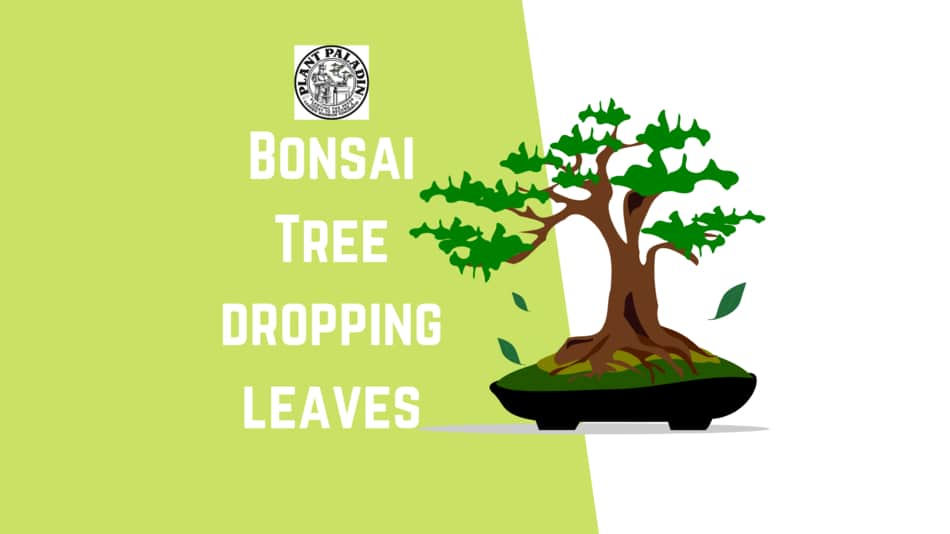
So last month the weather picked up here in the UK so I thought I’d move some of my bonsai outdoors. When I was getting up to move them however I noticed that the leaves had started to fall. Now, this has happened to me once before and it got me thinking; about what causes bonsai trees to drop their leaves?
Bonsai trees drop leaves when they are underwatered, overwatered, do not get enough sunlight, have an insect infestation, or disease of some kind. Some bonsai species that are not evergreen may also naturally lose their leaves as they get ready for the winter season.
So what can you do to prevent your bonsai from dropping leaves? And are bonsai trees dropping leaves always a cause for concern? Keep reading to find out more!
Just a quick heads up, over the past three years of running Plantpaladin, hundreds of people have asked for product recommendations. As such, You can find my favorite indoor bonsai tree here (link takes you to Bonsaiboy), my favorite outdoor bonsai tree (link takes you to Bonsaiboy), or have a look at all the products I recommend here.
Bonsai tree dropping leaves
Browse any bonsai forums, YouTube videos, or visit garden centers for long enough and sooner or later you will be inundated with bonsai leaf questions.
It’s easy to get super paranoid thinking something is wrong with your tree with your leaves not being the right color or big enough.
In most situations, however, these questions are usually fine one that can be a cause for concern is if your bonsai tree is dropping leaves.
To summarize your bonsai leaves should only lose leaves naturally in the following situations:
Your bonsai species is not a pine or evergreen species
non-evergreen bonsai species (which make up the majority of commercial bonsai trees) such as elms or ficus trees will naturally shed their leaves, as all plants will during the fall.
The time of the year
As mentioned above, during the fall or autumn, your bonsai, especially if they are kept outside and left to the elements will shed their leaves naturally.
Defoliation
Bonsai defoliation is the manual process of trimming either all or some of the leaves of your plant to created a more dense canopy when the leaves grow back.
If you use partial defoliation where you only trim away part of the leaves instead of all of them – this can lead to some shock loss in some of the leaves you did not trim back.
Now if your bonsai hasn’t lost its leaves because of any of the above reasons then it can be due to one of the following.
The good news is that if tackled early enough – these can be resolved:
- Underwatering
- Overwatering
- Disease
- Pests
- Light
- Temperature
Let’s explore these in more detail below:
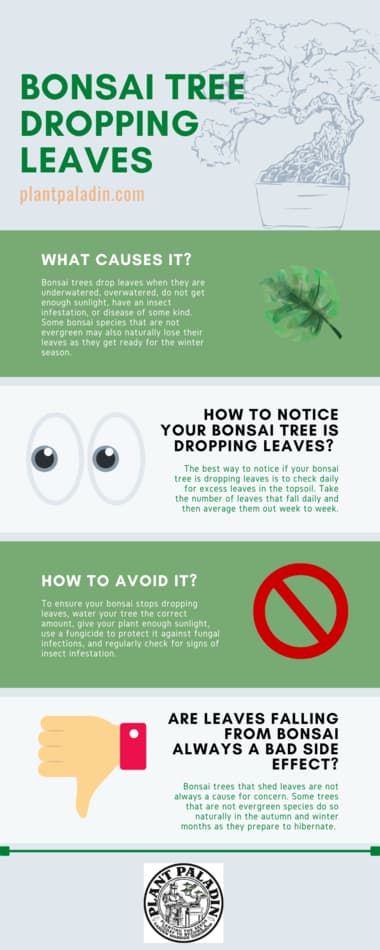
Overwatering can cause bonsai trees to drop leaves
While underwatering is a lot more common than overwatering, especially as bonsais are notorious for absorbing water, the most common symptom of overwatering a bonsai is that it can cause leaves to change color – and if severely dehydrated, cause its leaves to fall off.
This is because bonsai have to prioritize the trunk and root system of the plant meaning the first part of the plant it will shed is likely to be leaves – especially those leaves that are not as efficient.
So how do we stop bonsai trees from dropping their leaves?
Simply put, ensure you only water your bonsai when the soil is dry to the touch. If your topsoil is wet then your bonsai has more than enough water.
It’s also important to ensure you keep your bonsai tree in a pot with holes or with soil that is permeable so that the water can flow through the plant easily.
To find out more about this I would recommend checking out the following posts:
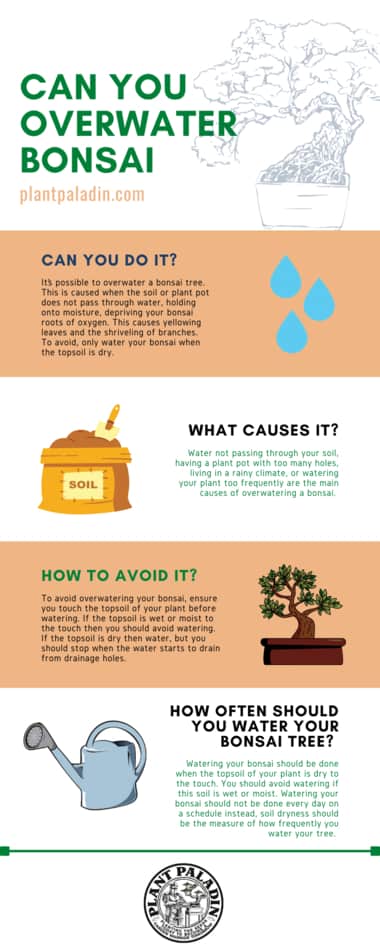
Underwatering a bonsai can cause dropping leaves
Underwatering is a much more common reason why your bonsai tree is dropping leaves.
Underwatering your bonsai can lead to it not being able to absorb light as well, start to wilt, and in severe cases cause leaves to fall off and your plant to eventually die.
Underwatering then is also a major issue in smaller bonsai plants that are such as fingertip bonsai-like Keshitsubo or Shito size classifications, which will dry out a lot faster.
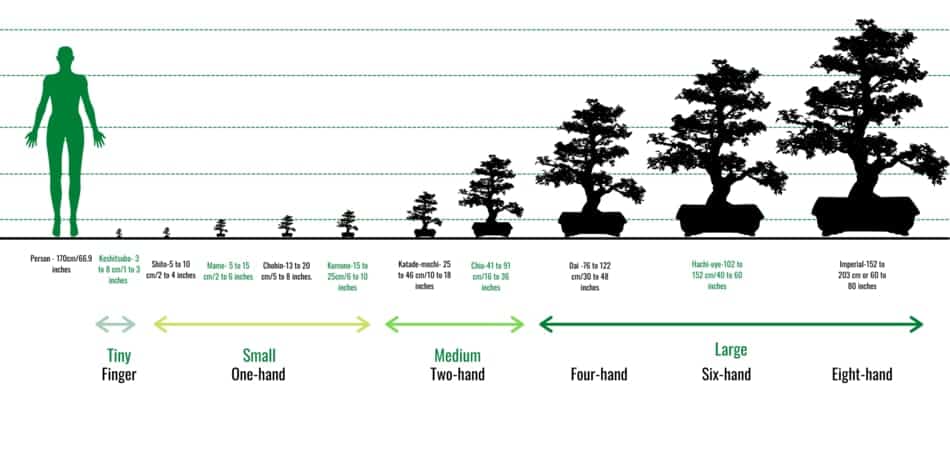
To avoid this, ensure you check your topsoil every day to see if it is dry (potentially multiple times a day for small bonsai)
If you find that it is too dry then water.
Now if you have not managed to water your bonsai for a few days because of vacation – submerging the pot of your bonsai underwater can be a great option to get some emergency water in your tree.
Now different bonsai sizes will need different amounts of water and drain holes to pass the water effectively – it’s a fine balance we bonsai holders have to get used to but hopefully, the table below should help:
| Classification | Size inches | Number of penny-sized holes | Number of pencil-sized holes |
| Keshitsubo | 1 to 3 inches | 1-2 | 0 |
| Shito | 2 to 4 inches | 1-2 | 0 |
| Mame | 2 to 6 inches | 2 | 2 |
| Chohin | 5 to 8 inches | 2 | 2 |
| Kumono | 6 to 10 inches | 2 | 2 |
| Katade-mochi | 10 to 18 inches | 2 | 3 |
| Chiu or Chumono | 16 to 36 inches | 2 | 4 |
| Dai or Omono | 30 to 48 inches | 3 | 6 |
| Hachi-uye | 40 to 60 inches | 4 | 8 |
| Imperial | 60 to 80 inches | 6 | 8 |
Disease
Another very common reason that causes your bonsai tree to drop leaves is that your bonsai tree has a disease.
Like people, plant species also suffer from many different illnesses and so this can be a major reason contributing towards your leaves falling.
The most common diseases that cause bonsai leaves to fall off then are as following:
- Fungal infections
- Mold infections
Fungal infections
Fungal infections are incredibly common and often attack the leaves on your tree – they often are displayed as white spots or white powder on the leaves of your tree and if left unchecked can cause the leaves to weaken and fall off.
To treat fungal infections use a fungicide to treat the leaves and within a few days, your bonsai should be as good as new.

Mold infections
Mold infections are also common when it comes to bonsai – usually, if you overwater your bonsai or there is poor drainage.
Mold infections usually start at the trunk of your tree and then work their way up the leaves where they will discolor your leaves and eventually cause them to fall off.
To treat mold infections on your bonsai, and wipe the tree down with a solution of one tablespoon of liquid soap, rubbing alcohol, and water.
Pests
Pests such as aphids, fungus gnats, whiteflies, spider mites, and scale are all incredibly common when keeping bonsai.
Bonsai owners then need to regularly check their plants for signs of insets if they want to avoid a full-blown insect infestation.
Now one of the side effects of some insect outbreaks like scale, is that they like to feed on the underside or sap of your leaves, which will cause them to weaken and eventually fall off.
Whilst each of the insects has its own way of being dealt with, the most common and effective way I found to deal with insect outbreaks is to do the following:
- Remove your bonsai plant to avoid infecting other plants
- Put on a pair of gardening gloves
- Use 70% rubbing alcohol in a cotton ball swab to rub down your plant in all the hard-to-reach areas, (leaves branches, etc) removing the white powder.
- Wipe down the planter/plant pot and topsoil with rubbing alcohol in a tissue
- Mix a solution of 30oz of water, two tablespoons of liquid soap, and 1 cup of rubbing alcohol in a solution
- Pour this solution in a spray bottle
- Spray your plant thoroughly
- Leave to dry for 24 hours
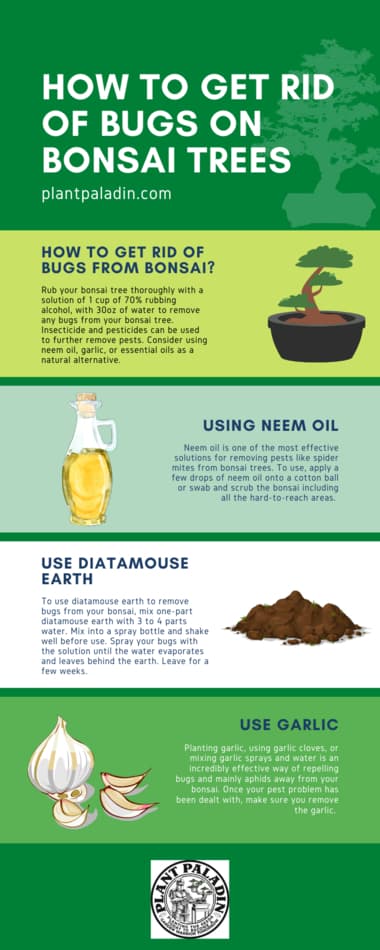
Light
If you think about it, the main purpose of the leaves on your tree is to absorb the sunlight to feed your plant – better known as photosynthesis.
If your plant then is not getting enough light for them then it can cause leaves to fall off so your plant can be as productive as possible.
This is especially common in indoor bonsai, so I’d advise moving your plants to the bright point of your house, potentially near a window if possible.
Just bear in mind your plan is likely to get super hot in the summer which can lead to more watering on your side.
Now if you keep your bonsai outdoors and they are still not getting enough light (quite common if you live in countries in northern Europe where sunlight is low) then I’d recommend getting something like a UV light which will give you direct access to light year-round.
If you do find that your bonsai is not getting enough natural light, a good option would be to defoliate your bonsai – this will remove all the leaves from your tree but after a few months if done correctly cause your leaves to double in size.
The more leaves your bonsai has, the more light it will be able to absorb and the happier and healthier it will be.
Temperature
Finally, we come to temperature.
Now the reason I have put this one last is that it’s the least common reason why your bonsai will lose its leaves.
That being said if you live in a very harsh cold environment such as northern Siberia or an incredibly warm and hot environment such as northern Africa then changes in temperatures may prove an issue – especially if you just got your tree.
You see most bonsai trees are manufactures in the far east, in countries like China and Japan.
This means that they will prefer temperatures that best match those locals.
Whilst bonsai are very adaptable to most climates, if you live in an extremely different climate it can cause some shock loss of leaves.
To solve this, I’d recommend keeping your bonsai indoors for a few months where you can actively monitor the temperature and ease it into your local climate.
In winter I would also consider winterizing your bonsai tree or building your own cold frame as a way to keep your plants safe from cold conditions.
How to know when your bonsai tree dropping leaves is a problem?
Bonsai trees dropping leaves is a problem when it’s occurring outside of them preparing for winter, or some shock loss from defoliation or pruning. Common causes for concern are underwatering or overwatering your tree, fungal disease, insect infestation, or lack of light.
Outdoor bonsai dropping leaves
If you keep your bonsai species outdoors or own a species that is more used to being kept outdoors than indoors such as Chinese Elm or Evergreens, then some of the causes of your bonsai dropping leaves are going to be more common than others.
For example, if your bonsai is kept outdoors, you won’t have control over the amount of water your bonsai will receive daily.
If you live in a rainy climate it was going to be a lot more common than to overwater your bonsai.
You also have an increased risk of insect infestation which can further add to your bonsai tree dropping leaves.
Indoor bonsai dropping leaves
If you keep your bonsai indoors or own species such as ficus that are perfect to be kept indoors then other problems are more common that can lead to your bonsai tree dropping leaves.
The biggest one being the lack of natural light.
As your bonsai is kept indoors, it will not get as much natural light as it would outdoors, even if you put it near the window.
As such it is important if you keep your bonsai in a windowless dark room to give it light by moving it or investing in something like a UV light for best results.
What do the experts say?
Now I wanted to make sure that it was not just my experience that gave reasons as to why bonsai leaves were dropping off so I visited my local botanical gardens and asked one of the caretakers their thoughts.
“ The biggest cause for leaves falling off on your bonsai is going to be overwatering. It causes the leaves to start to wilt and eventually fall off which is mainly caused by something called root rot” – Botanical Gardens.
They also mentioned that planting a bonsai in the ground is a good way to get rid of overwatering a bonsai or using something like a hairdryer to dry out your soil.
Are leaves falling from bonsai always a bad side effect?
Bonsai trees that shed leaves are not always a cause for concern. Some trees that are not evergreen species do so naturally in the autumn and winter months as they prepare to hibernate.
Pruning your tree or defoliating part of the tree can also cause some shock loss of leaves which is also natural.
How to prevent your bonsai from dropping leaves?
To ensure your bonsai stops dropping leaves, water your tree the correct amount, give your plant enough sunlight, use a fungicide to protect it against fungal infections, and regularly check for signs of insect infestation.
How to notice your bonsai tree is dropping leaves?
The best way to notice if your bonsai tree is dropping leaves is to check daily for excess leaves in the topsoil. Take the number of leaves that fall daily and then average them out week to week.
If your bonsai is shedding more leaves as time goes on, consider adjusting the water or light levels of your plant as well as looking out for signs of insect infestation or white spot fungal infections.
My top picks for the gear you will need!
So like I mentioned earlier, over the past three years of running PlantPaladin, hundreds of people have asked me for my recommendations on the best bonsai gear on the market.
Having spent thousands of dollars on bonsai items these past few years and tested at least 100 bonsai-specific products, I’ve listed my favorite products below – All of which I highly recommend and think you can get great value.
They can purchase directly by clicking the link to take them to Amazon.
Bonsai Tool Set: One of the significant challenges I’ve had is finding a toolset that was not only durable but didn’t break the bank. SOLIGT has recently developed a fantastic bonsai tool set that covers all the tools you need to trim, prune, and repot your trees. – You can grab it here.
Complete Bonsai Set: Many of you will want to grow your bonsai trees entirely from scratch, but finding the varicose seeds, pots, and other items in one place can be challenging. Leaves and Sole then have created a complete bonsai set that I’ve personally used that ticks all the boxes. You can grab it here.
Bonsai wire: The number of times I’ve run out of wire for my bonsai or purchased cheap bonsai wire that doesn’t do the job is embarrassing for me to admit. After a lot of trial and error, I found that using Hotop’s aluminum bonsai wire is one of the best options on the market. This can easily be used for both indoor and outdoor bonsai. You can grab it here.
This post was written by Fehed Nicass who has been passionate about bonsai for over 2 years. He currently resides in the UK and works in sales.
